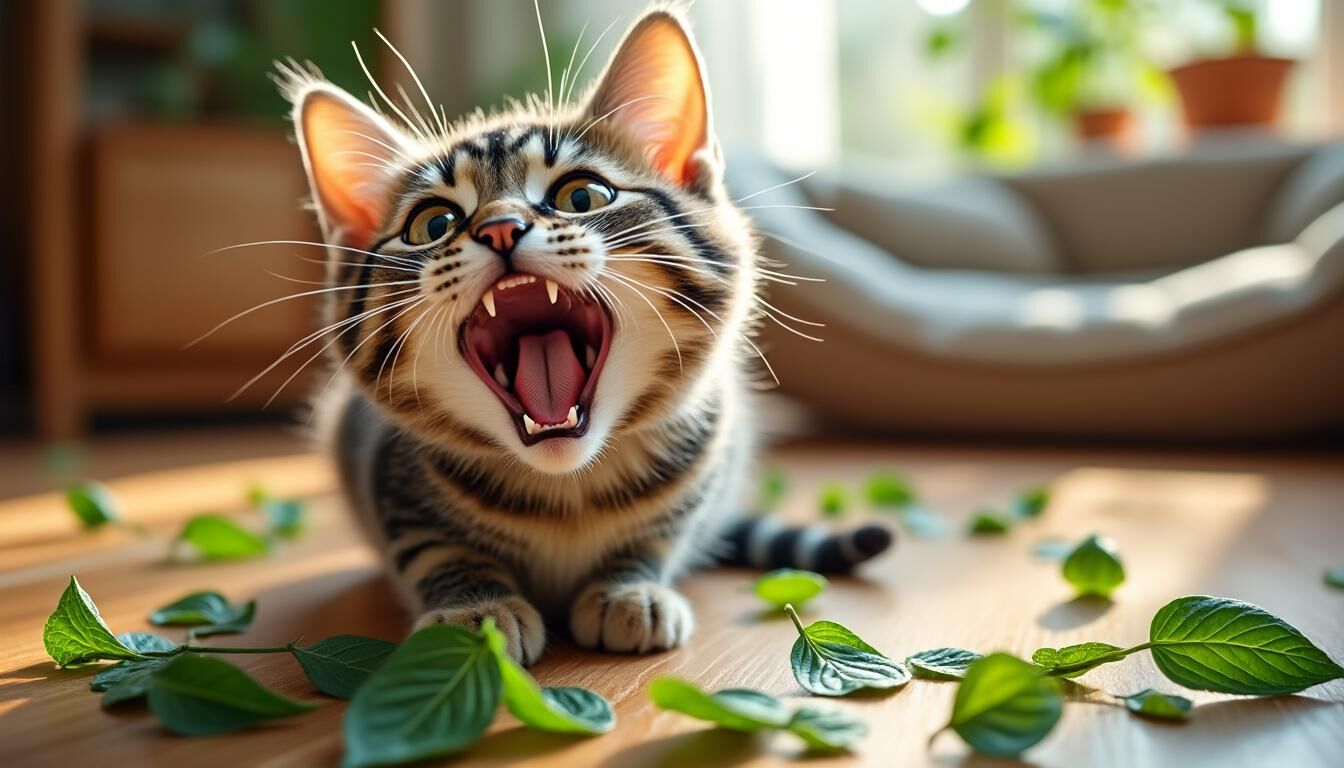Catnip, a fascinating herb treasured by cat lovers worldwide, sparks a wide range of intriguing reactions in cats— from lively play sessions to moments of deep relaxation. This effect traces back to a unique chemical profile found in the plant, captivating cats and stirring curiosity among pet owners and scientists alike. Originating from regions spanning North America, Europe, and Asia, the plant Nepeta cataria belongs to the mint family and has been known beyond feline entertainment for its traditional uses in herbal medicine and natural insect repellents. But what exactly is responsible for its compelling impact on cats?
At the heart of catnip’s effects lies the compound nepetalactone, concentrated mainly in its leaves and stems. When cats crush or rub the herb, this compound is released into the air, interacting with their highly sensitive olfactory system. Scientific research reveals the complex biological interplay between nepetalactone and feline sensory organs, offering insight into the spectacular behaviors triggered. Understanding these mechanisms not only enlightens cat behavior enthusiasts but also empowers owners to enrich their pets’ environment responsibly, enhancing well-being and entertainment.
While the effects are well-documented, the reaction to catnip is not uniform. Roughly 50-70% of cats respond, influenced by genetics and developmental stages, while others remain indifferent throughout their lives. The duration and intensity of catnip’s influence vary in each cat, creating unique interaction patterns that evolve with exposure and age. This article explores the botanical, neurological, and practical dimensions of catnip, uncovering the why and how behind its famous feline allure.
🌿 What Is Catnip? Understanding Nepeta Cataria and Its Unique Chemical Profile
🧪 Nepetalactone: The Active Compound in Catnip and How It Works
Catnip owes its power to nepetalactone, a volatile oil present in the leaves, stems, and seeds of Nepeta cataria. This compound is released when the herb is crushed or rubbed, turning a simple plant into a potent stimulus for felines. The molecule’s structure allows it to mimic natural feline pheromones, triggering a complex sensory response when inhaled.
Some notable facts about nepetalactone’s role include:
-
It vaporizes easily, allowing cats to detect it through their sense of smell. 🌬️
-
It binds to receptors found specifically in feline nasal tissue, initiating a neurological cascade. 🧠
-
It induces the release of endorphins, which promote euphoria or stimulating sensations analogous to a natural high. 😊
This biological trigger is unique to cats and similar felines like tigers, which also show sensitivity to catnip, highlighting an evolutionary trait among certain members of the feline family.
|
Component |
Location in Plant |
Function |
Effect on Cats |
|---|---|---|---|
|
Nepetalactone 🧪 |
Leaves and Stems |
Olfactory stimulant |
Euphoria, playfulness, sensory arousal |
|
Other Terpenoids |
Whole plant |
General aroma |
Possible mild stimulation |
🌍 Origins and Traditional Uses of Catnip Beyond Feline Stimulation
Originally native to North America, Europe, and parts of Asia, catnip has a rich history extending far beyond its fame among cats. Historically, it was valued in herbal medicine for:
-
Its mild sedative properties, used to alleviate headaches and insomnia. 🌿
-
Digestive benefits for humans, such as easing stomach cramps and indigestion. 🍵
-
A natural insect repellent, effective against mosquitoes and other pests. 🦟
These diverse applications illustrate catnip’s multifunctional role as a herb, appreciated for both its aromatic qualities and practical benefits. While its impact on humans differs significantly from its effects on cats, this herb continues to fascinate cultures around the globe.
🌱 Identifying Catnip: Physical Traits and Botanical Classification
Catnip is a hardy, herbaceous perennial plant belonging to the mint family (Lamiaceae). Some distinguishing characteristics include:
-
Heart-shaped, serrated green leaves covered in fine hairs. 🍃
-
Square-shaped stems, typical of many mint family plants. 🌿
-
Clusters of small, white to pale lavender flowers blooming mainly in summer. 🌸
-
Growth height of 60–100 cm (2–3 feet).
Its botanical name, Nepeta cataria, reflects its genus and species, classifying it among other Nepeta varieties, some of which also attract felines but often with less intense effects. Gardeners and cat owners alike appreciate catnip for its easy cultivation and its ability to naturally attract cats for healthy interaction.
🐱 How Does Catnip Affect Cats? Exploring Biological and Neurological Mechanisms
🧠 Vomeronasal Organ, Olfactory Triggers, and The Cat’s Euphoric Response
The magic of catnip lies in its interaction with the cat’s sensory system, particularly the vomeronasal organ (VNO) — a specialized part of the nasal cavity responsible for detecting pheromone-like compounds. When a cat inhales nepetalactone, it binds to receptor sites within the nasal mucosa and triggers a signal to the brain’s limbic system, an area controlling emotions and behavior.
This neurological activation explains why cats exhibit such varied yet characteristic responses to catnip. The brain releases natural chemicals like dopamine and endorphins, producing feelings of euphoria or mild hallucination-like effects. This chain reaction doesn’t harm cats but stimulates them in a way specific to their species.
🎉 Common Catnip Behaviors: Rolling, Rubbing, Hyperactivity, and More
Cats exposed to catnip often display a vibrant palette of behaviors including:
-
🐾 Rolling on the ground and rubbing their face and body against the catnip source.
-
😺 Increased vocalizations such as meowing or purring.
-
🎾 Sudden bursts of playfulness or hyperactivity.
-
🛋️ Sprawling out in a relaxed state following active play.
-
💞 Seeking affection or engaging in cuddling after stimulation.
Occasionally, some cats may also show aggression when overstimulated, especially in environments with multiple felines, highlighting the need to observe individual responses carefully.
🔬 Why Some Cats Don’t React to Catnip: The Role of Genetics and Age
Not all cats experience the delightful stimulant effects of catnip. Sensitivity is heredity-based — approximately 30-50% of cats lack the genetic markers needed to respond. Moreover, kittens don’t typically react until they reach about 3 to 6 months of age, as their neurological pathways are still maturing.
Further influencing factors on catnip response include:
-
Genetic makeup controlling the expression of olfactory receptors.
-
Individual variations in sensory processing.
-
Age and developmental stage.
This normal variation underscores why some cats might ignore catnip entirely, while others become highly engaged.
⏳ Catnip Duration and Sensitivity: How Long Effects Last and Why Exposure Matters
🕒 Typical Catnip Response Time: From Playful Highs to Refractory Periods
The effects of catnip usually last between 10 to 30 minutes. During this time, cats cycle through various behaviors from excitement to calm relaxation. Afterward, most cats enter a refractory period lasting up to two hours, during which they become temporarily unresponsive to additional catnip exposure.
Understanding this cycle is crucial for maintaining the catnip’s effectiveness as overstimulation or constant exposure can dull the reaction.
|
Phase ⏳ |
Duration |
Description |
|---|---|---|
|
Active Phase |
10-30 minutes |
Euphoria, playful or relaxed behavior |
|
Refractory Period |
1-2 hours |
Temporary insensitivity to catnip |
|
Recovery |
Variable |
Return to normal baseline behavior |
🔄 Habituation and Tolerance: Avoiding Overexposure for Continued Fun
Repeated or excessive catnip use can lead to tolerance, where the cat’s neurological receptors become less responsive. To avoid habituation, owners are encouraged to limit catnip sessions to a few times per week, allowing the cat’s sensitivity to reset and maintain the charm of its interaction with this herb.
👶 Kitten Development: When Do Young Cats Start Reacting to Catnip?
Kittens generally begin reacting to catnip when they reach around 3 to 6 months, corresponding with the development of the VNO and other olfactory systems. Before this stage, the herb usually fails to elicit the signature behaviors in young cats. Offering catnip after this period can help kittens explore playful behaviors safely and encourage healthy development.
🏠 Practical Uses of Catnip for Cat Owners: Play, Training, and Alternatives
🎲 Best Catnip Delivery Methods: Toys, Sprays, Bubbles, and Fresh Herbs
Catnip can be introduced through various creative delivery methods designed to captivate cats and promote positive behaviors:
-
🎾 Catnip-infused toys offering interactive play sessions.
-
🌿 Fresh or dried catnip leaves for scent exposure and rubbing.
-
💨 Catnip sprays, suitable for cats sensitive to ingesting the herb.
-
🫧 Novelty items like catnip bubbles that encourage chasing and jumping.
Each medium offers different benefits depending on the cat’s preferences and health considerations.
🛋️ Catnip in Feline Training and Enrichment: Stimulating Exercise and Good Behaviors
Incorporating catnip into training routines can enhance motivation and bonding. For example, rubbing catnip on scratching posts encourages use and deters furniture scratching. Using catnip toys during guided play stimulates exercise, prevents boredom, and channels natural predatory instincts into safe outlets, improving overall behavior and well-being.
🍃 Alternatives for Non-Responsive Cats: Silvervine, Valerian Root, and More
For cats unresponsive to catnip, other plants can provide similar stimulating effects, such as:
-
🌿 Silvervine: Contains actinidine, another feline-attracting compound.
-
🌱 Valerian root: Known to produce calming or stimulating reactions depending on the cat.
-
🍂 Tatarian honeysuckle: Another natural cat attractant used in toys.
Trying these alternatives supports diverse feline preferences and maintains enrichment opportunities.
⚠️ Catnip Safety and Side Effects: Myths, Facts, and Responsible Use
✅ Is Catnip Safe? Understanding Non-Toxicity and Moderation for Cats
Catnip is non-toxic and safe for cats when given in moderation. Occasional ingestion of the herb is generally harmless. Minor side effects, rarely observed, may include mild gastrointestinal upset or temporary dizziness if consumed excessively. However, there is no evidence of long-term harm or addiction linked to catnip use.
Best safety practices for owners include:
-
Controlling quantity and frequency of exposure.
-
Ensuring the cat is supervised during play to prevent overeating.
-
Avoiding exposure in cats with respiratory issues exacerbated by strong scents.
😼 When Catnip Triggers Aggression: Multi-Cat Homes and Monitoring Tips
Though rare, some cats display aggression when exposed to catnip, particularly in households with multiple feline companions. Overstimulation can worsen territorial disputes or jealousy. Owners should:
-
Introduce catnip gradually.
-
Monitor interactions closely.
-
Provide separate play areas or times for cats if needed.
-
Withdraw catnip if signs of stress or hostility appear.
🌿 Catnip and Humans: Historical Uses as Sedative, Digestive Aid, and Insect Repellent
Beyond its feline fame, catnip has held various uses in human traditions. Its history includes applications as a mild sedative to ease anxiety and headaches, a digestive herb for stomach relief, and a natural insect repellent. These effects, largely due to different compounds than those stimulating cats, confirm catnip’s versatile nature as a herb across species but also reinforce that its effects on humans differ considerably from those on cats.

FAQ about Catnip and Cats
-
Q: Why do some cats not react to catnip?
A: Sensitivity to catnip is genetic. Around 30-50% of cats lack the receptors needed to respond, and kittens often don’t react until at least 3 months old. -
Q: Can catnip cause addiction in cats?
A: No, catnip is not addictive. Cats may develop tolerance if overexposed, but it does not cause dependence. -
Q: How long does catnip’s effect last?
A: Typically, effects last 10-30 minutes, followed by a refractory period during which cats won’t respond for up to two hours. -
Q: Is catnip safe for all cats to use?
A: Yes, in moderation catnip is safe. Overconsumption may cause mild digestive upset, but it is non-toxic. -
Q: Are there alternatives for cats that don’t respond to catnip?
A: Yes, silvervine, valerian root, and Tatarian honeysuckle offer similar stimulating effects for non-responsive cats.

